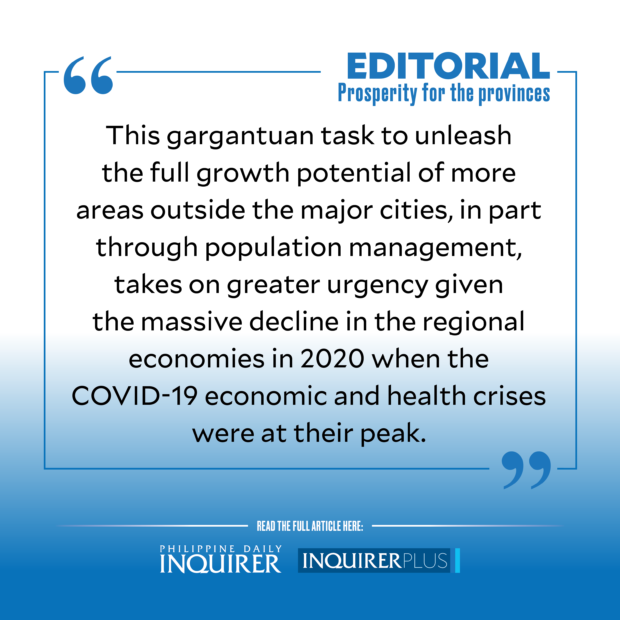Prosperity for the provinces
Michael del Mundo of the University of the Philippines’ Population Institute revealed early this week sobering research findings that only three of the country’s 17 regions are expected to reap the social and economic benefits of effective population management.
According to Del Mundo, only the National Capital Region, Calabarzon, and the Cordillera Administration Region would likely see accelerated economic growth due to the “demographic dividend” that comes from having a largely productive or earning population. This is not the case in “most notable” laggards Bangsamoro Autonomous Region in Muslim Mindanao, Zamboanga Peninsula, Western Visayas, Mimaropa, Bicol Region, and Eastern Visayas.
“The scenario in the lagging regions … we can summarize it as having a relatively higher number of effective consumers compared to their number of effective workers,” said Del Mundo, “This suggests that resources are tied up to consumption and expenditure instead of investment and savings. Spending is more on basic services and necessities instead of investing for growth.”
For these regions to catch up, Del Mundo said urgent and comprehensive government action was needed to, among others, address high fertility rates and improve the education and health situation to enhance the quality and quantity of human resources. Also, labor market conditions must be improved by creating more jobs, addressing youth unemployment, and including more women in the labor force.
This gargantuan task to unleash the full growth potential of more areas outside the major cities, in part through population management, takes on greater urgency given the massive decline in the regional economies in 2020 when the COVID-19 economic and health crises were at their peak.
The latest Philippine Statistics Authority data on regional economic growth showed that the economic output of all regions dropped in 2020, with the worst recorded by Central Luzon at 13.9 percent, followed by Calabarzon, 10.5 percent; and NCR, the country’s economic powerhouse, at 10.1 percent.
The Bangko Sentral ng Pilipinas (BSP), in its latest report on Regional Economic Developments in the Philippines, said that all production sectors were ravaged in 2020, including the vital agriculture, fishery and forestry, services including tourism, as well as transportation and construction—all key employers in the provinces.
Overall, the unprecedented pandemic caused a 9.6-percent contraction in the country’s total gross domestic product, the worst since World War II.
More parts of the economy have fortunately opened up with COVID-19 cases declining to manageable levels, but the country’s economy is yet to fully recover even after two years. The International Monetary Fund, in fact, expects the Philippines to revert to its enviable pre-pandemic growth levels only by 2024, among the last in Southeast Asia to do so.
Even this projection is threatened by soaring prices of oil and basic goods and services, a fallout of the protracted Ukraine-Russia war. And despite the seeming return to “normal,” the pandemic still has the Philippines in its grip, and the next administration should count urgently addressing the “scarring effects” of the economic and health crises, such as joblessness and weakened consumption, particularly outside the urban centers, among the first things it should do.
The BSP has proposals on how to do that — through rehabilitation of irrigation projects and construction of farm-to-market roads to ramp up agricultural production to the use of the Rice Competitiveness Enhancement Fund to increase the rice output nationwide, and financial support to micro, small, and medium enterprises to help them sustain their operations and halt further retrenchment of workers.
To spur recovery and sustain socioeconomic growth in the regions, the BSP also said that there was “a need for reliable and affordable power supply; better interconnectivity between rural/far-flung areas and the regions’ major economic centers through adequate infrastructure and efficient transport systems; improved ease of doing business; and lasting peace and order situation.”
And as tourism has become a major source of income and job opportunities in many regions, tourism sites should be upgraded and prepared to handle COVID-19 concerns.
The BSP noted that the completion of the flagship “Build, build, build” projects and roads leading to tourism sites, ports, production areas, and industry corridors will be vital in reviving the local economy.
The government is confident that the impact of the COVID-19 crisis on the economy, while severe, is “transitory.” The macroeconomic fundamentals, such as its young and growing population and resilient economy, will ensure that the Philippines will get back on the path of rapid growth.
But as the BSP correctly pointed out, the aim is not to simply recover but to ensure that programs and projects will be effectively carried out to create “resilient, healthy, secure, technology-savvy, inclusive, and prosperous communities in the regions.”
After all, prosperity should not be just for the centers, but for the peripheries as well.

















